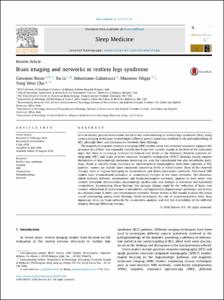Brain imaging and networks in restless legs syndrome
- Keimyung Author(s)
- Cho, Yong Won
- Department
- Dept. of Neurology (신경과학)
- Journal Title
- Sleep Medicine
- Issued Date
- 2017
- Volume
- 31
- Keyword
- Restless legs syndrome; Imaging; MRI; Connectivity; Pathophysiology; Network
- Abstract
- Several studies provide information useful to our understanding of restless legs syndrome (RLS), using
various imaging techniques to investigate different aspects putatively involved in the pathophysiology of
RLS, although there are discrepancies between these findings.
The majority of magnetic resonance imaging (MRI) studies using iron-sensitive sequences supports the
presence of a diffuse, but regionally variable low brain-iron content, mainly at the level of the substantia
nigra, but there is increasing evidence of reduced iron levels in the thalamus. Positron emission tomography
(PET) and single positron emission computed tomography (SPECT) findings mainly support
dysfunction of dopaminergic pathways involving not only the nigrostriatal but also mesolimbic pathways.
None or variable brain structural or microstructural abnormalities have been reported in RLS
patients; reports are slightly more consistent concerning levels of white matter. Most of the reported
changes were in regions belonging to sensorimotor and limbic/nociceptive networks. Functional MRI
studies have demonstrated activation or connectivity changes in the same networks. The thalamus,
which includes different sensorimotor and limbic/nociceptive networks, appears to have lower iron
content, metabolic abnormalities, dopaminergic dysfunction, and changes in activation and functional
connectivity. Summarizing these findings, the primary change could be the reduction of brain iron
content, which leads to dysfunction of mesolimbic and nigrostriatal dopaminergic pathways, and in turn
to a dysregulation of limbic and sensorimotor networks. Future studies in RLS should evaluate the actual
causal relationship among these findings, better investigate the role of neurotransmitters other than
dopamine, focus on brain networks by connectivity analysis, and test the reversibility of the different
imaging findings following therapy.
- Keimyung Author(s)(Kor)
- 조용원
- Publisher
- School of Medicine
- Citation
- Giovanni Rizzo et al. (2017). Brain imaging and networks in restless legs syndrome. Sleep Medicine, 31, 39–48. doi: 10.1016/j.sleep.2016.07.018
- Type
- Article
- ISSN
- 1389-9457
- Appears in Collections:
- 1. School of Medicine (의과대학) > Dept. of Neurology (신경과학)
- 파일 목록
-
-
Download
 oak-2017-0389.pdf
기타 데이터 / 1.24 MB / Adobe PDF
oak-2017-0389.pdf
기타 데이터 / 1.24 MB / Adobe PDF
-
Items in Repository are protected by copyright, with all rights reserved, unless otherwise indicated.